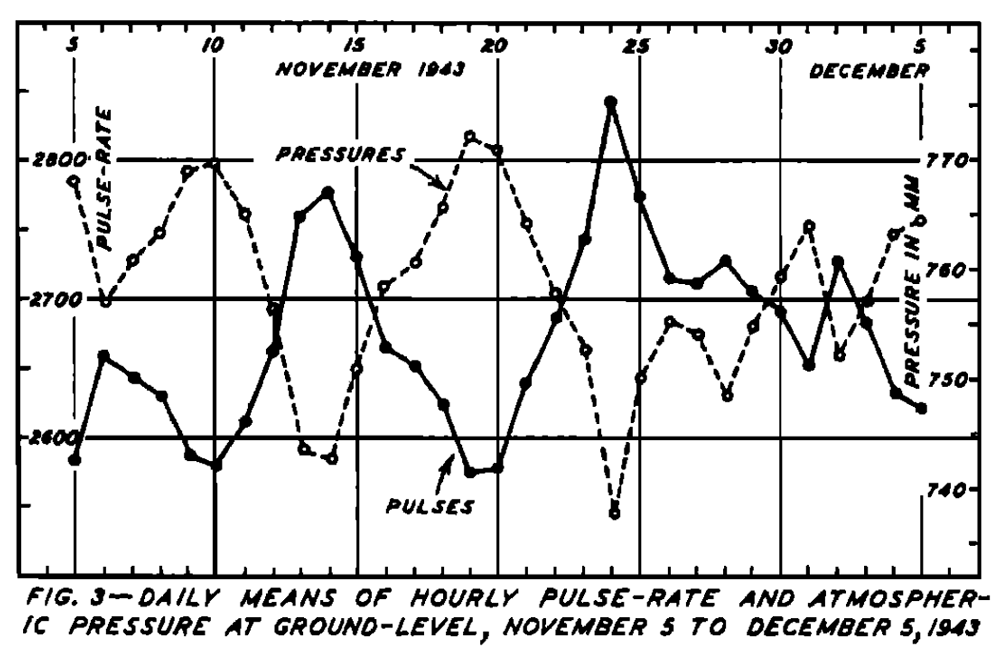What is Arturo Duperier's main contribution to physics and the study of cosmic rays?
Arturo Duperier began his scientific career around 1920 working with Blas Cabrera on the magnetism of matter while at the same time securing a job as a meteorologist. In the early 1930s he began to work on atmospheric electricity, a field quite close to that of cosmic rays, which he entered after a study trip to Germany in 1934. Just then this field was experiencing a golden age as it was being incorporated into the nascent field of particle physics.
In May 1938 he went into exile in the UK, fleeing from the Spanish Civil War, with the intention of continuing his work on cosmic rays, and a year later he joined the team of Patrick Blackett, one of the leading figures in the field, in Manchester. In March 1940 he moved the laboratory to London and, while his colleague and friend was involved in the war effort, he began a series of observations which the Blitz (1) did not interrupt and which would lead to his greatest contribution to physics in the late 1940s.
In the late 1930s, Blackett and other physicists had established that the main component of cosmic rays reaching the Earth's surface was made up of unstable elementary particles that we now call muons (2). These would be the product of the decay of other unstable and much shorter-lived particles, the pions - and, as we know today, also kaons - which are created in the collisions of the primary cosmic rays, coming from our galaxy and beyond, with the upper layers of the Earth's atmosphere.
With his apparatus - very similar to CRIS, the MUNCYT detector: parallel trays of Geiger tubes - installed first on a high floor at Imperial College and at Holborn tube station and finally at Birkbeck College, Duperier very carefully measured the intensity of cosmic rays, i.e. the number of particles detected per unit time.
Duperier compared his records with surface and high-altitude pressure and temperature data - the latter obtained by British Meteorological Service balloon probes - and found remarkable correlations.
For example, as pressure rises, the intensity of cosmic rays falls, as shown in this figure from one of his main papers:

Fig. 1 A new cosmic-ray recorder and the air-absorption and decay of particles.
Duperier, A. (1944). A new cosmic-ray recorder and the air-absorption and decay of particles. Terrestrial Magnetism and Atmospheric Electricity, 49(1), 1-7.
Knowing that muons can be absorbed - or rather, disappear and give rise to other particles - when interacting with atomic nuclei in the atmosphere, it is easy to understand why: the higher the pressure, the higher the air density, the more interactions and the more absorption, i.e., the fewer the muons.
With respect to temperature, there are two effects that have opposite directions. First, Blackett proposed around 1938 that as the temperature of the upper layers of the atmosphere increases, the intensity of cosmic rays decreases because the atmosphere expands and muons are created further away from the surface, so they have more time of flight during which to decay and be absorbed. On the other hand, Duperier proposed in 1949 that as the temperature in the upper layers of the atmosphere - more precisely the layer where secondary cosmic rays are created - increases, the density decreases and the pions are less likely to be captured and disappear before disintegrating into the muons that will then reach the surface.
Duperier proposed an empirical model that took all these effects into account. He then statistically analysed the large amount of good data he had collected and looked for the best fit with the model, the one that maximised the correlations between the different variables: the best fit was obtained by assuming that muons were created by disintegration of pions in cosmic ray showers at an average height of about 16 km and had a half-life of the order of 2 billionths of a second.
(1) The systematic bombing campaign that Nazi Germany carried out over the United Kingdom between September 1940 and May 1941 is known as the Blitz, when London, for example, was attacked 71 times, with a third of its homes damaged or destroyed. After his departure from Madrid in 1936, Duperier could have said for the second time what George Orwell said in England Your England (1941): "As I write, highly civilised human beings are flying overhead, trying to kill me".
(2) More information about elementary particles at https://particleadventure.org/ or, only in Spanish, in the Experimenta booklet "Cosmic rays": http://www.muncyt.es/stfls/MUNCYT/Publicaciones/rayos_cosmicos_muncyt.pdf

